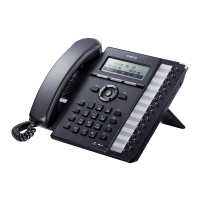IP8830E IP Phone
User Guide
1
1. IP8830E IP Phone Overview
Your new Ericsson-LG IP8830E Phone is an Internet Protocol (IP) phone employing Session Initiation
Protocol (SIP), the well-known open standard for establishing, managing and terminating a
communication session. IP8830E Phone interoperates with call servers, proxies and gateways to
exchange SIP signaling messages for call control. Real-time Transport Protocol (RTP) packets deliver
voice between the end-points over a managed IP network.
Features available to IP8830E Phone through SIP call servers are similar to those of a conventional
business telephone. In addition to the features described in this guide, your call server may provide
additional features, often using dialed feature codes. Refer to your system administrator for further
information.
The IP8830E Phone has fixed feature buttons, soft feature keys, flexible buttons that are configurable,
and dial pad buttons as shown in the figure below.
The twenty-four (24) flexible buttons access lines and features based on the IP Phone configuration.
Flexible buttons assigned for line access, called line buttons, represent a telephone line or a SIP user. A
line may be private, calls to a private line signal at all appearances of the line but an active or held call is
only visible and accessible by the original end-points. A shared line appears at multiple phones and all
calls are visible and accessible by all end-points with the line. Each line button employs LEDs to indicate
status as shown below.
24 Flexible buttons w/Red/Green LEDs Line or
feature assigned in Phone configuration. Default
assignment for buttons 1 and 2 are primary and
secondary Line appearance for the extension.
Navigation Controls
Left, use to view previous menu when return arrow appears.
Right, use to see additional menu items when ->appears.
Up, use to view Call log when phone is idle.
Down, use to access Phone Book while phone is idle.
OK, center button, use to select current item or save value in
LCD Menu.

